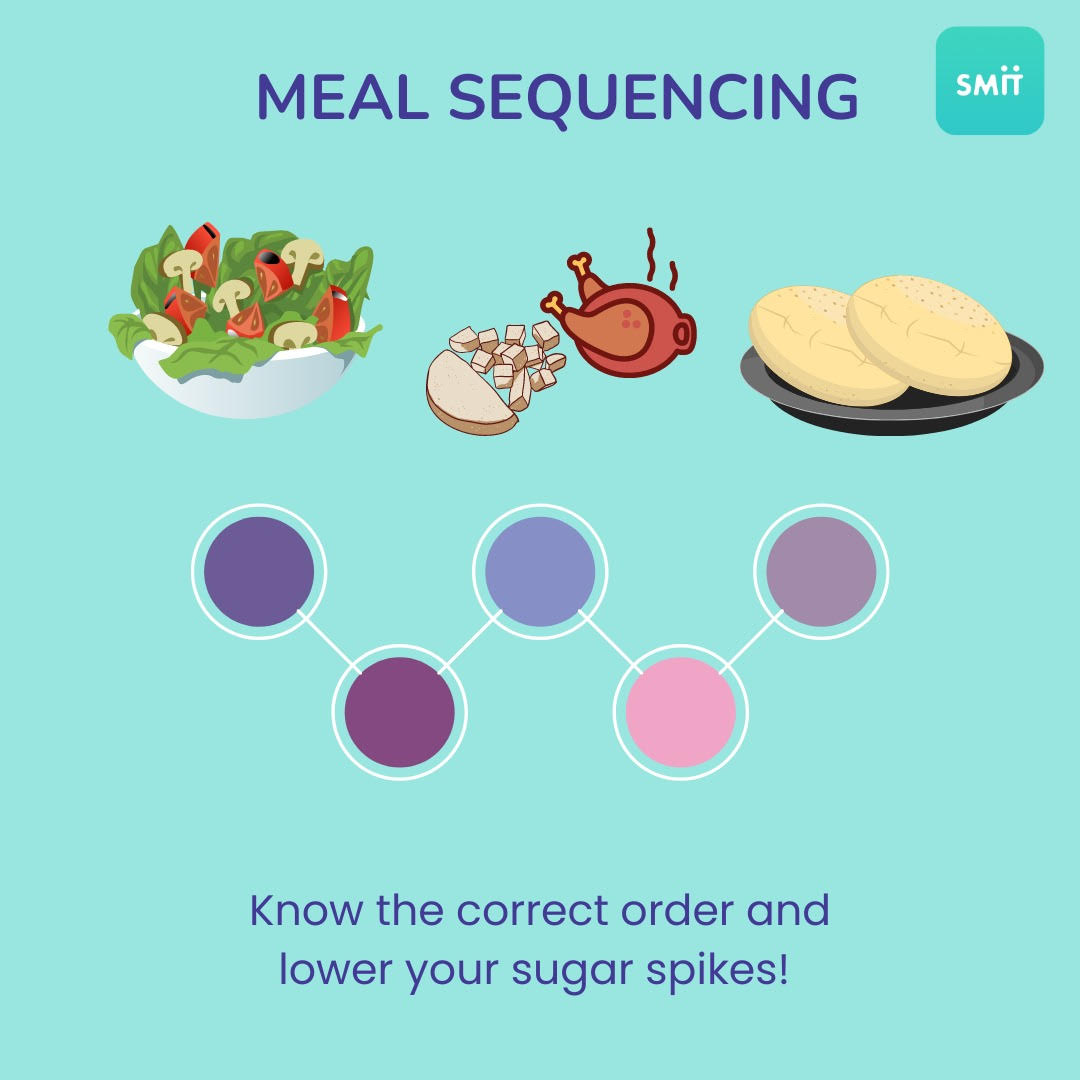All of us must have heard having healthy salad first is beneficial, i.e high fibre diet.! But have you wondered why? It’s basically a strategy of eating any food in a precise order to help in fat loss, reduce glucose responses, and manage energy intake. This technique of eating certain foods before others are known as Meal Sequencing. It refers to the sequence in which the macronutrients, i.e, Carbohydrate Protein and Fats, and Dietary Fibre in a meal are consumed. It has been indicated that consuming protein, dietary fibre, and/or fat before carbohydrates may be advantageous. Various studies have indicated that taking high protein food items and high fibre first in your main meals helps you to produce early satiety, keeping you from ingesting more calories and carbohydrates than your body requires at that moment. Carbohydrates are necessary in our daily meals, and instead of completely opting for a zero-carb food items, we can simply consume carbohydrates only necessary to our bodies in desired amounts by simply changing the meal sequence, without starving, and changing our basic daily menu which we have been eating for decades, which allows us to make an easy sustainable change in our diet pattern.
How does Meal Sequencing Impact your Blood Glucose Level
Carbohydrates are efficiently converted into useful energy (glucose) by the body. As a result, carbohydrates are an excellent source of quick energy. When consumed alone, however, this can frequently result in larger glucose spikes, energy falls, and feeling hungry again rapidly. According to one research in 2020, meal sequencing, or eating protein and/or fat before carbohydrates, increases glucagon-like peptide-1 release (GLP-1). A Review of Recent Findings on Meal Sequence: An Attractive Dietary Approach to Prevention and Management of Type 2 Diabetes. This hormone inhibits insulin and glucagon release. This combination has been demonstrated to enhance postprandial glucose responses. GLP-1 has also been demonstrated to reduce appetite by delaying stomach emptying, allowing you to feel fuller for longer. As a result, meal sequencing may aid in reducing glucose fluctuations and achieving more steady readings.
The Advantages of Meal Sequencing
Fat Loss: Satiety is always an important aspect of fat reduction. The objective of any weight reduction journey is to feel satisfied while simultaneously losing weight. Meal sequencing helps reduce significant glucose fluctuations, which is good not just for glucose management but also for satiety.
Filling up on high fibre diet before carbohydrates frequently results in lower energy consumption. This helps to satisfy ¼th of our satiety, resulting in reduced carbohydrate consumption. This suggests that these foods are full, high in nutrients, and low in calories. Natural protein and fat sources are also nutrient-rich and give the body long-lasting energy, resulting in longer-lasting sensations of satiation.
Avoiding Blood Sugar Spikes That Cause Vessel Damage : When we consume simple carbohydrates, the body quickly absorbs glucose. Glucose spikes can occur when glucose is quickly absorbed by the body. High glucose levels may induce microvascular and endothelial damage, as well as oxidative stress.
So, including additional dietary components such as high fibre diet, high protein food items, or fat in the meal helps to slow down glucose digestion. Because the body needs to work harder to use glucose for energy, glucose absorption into the bloodstream takes longer. This frequently serves to reduce the rise in glucose and can smooth out a glucose spike. When carbohydrates are consumed after protein, fibre, or fat, the digestion of carbohydrates and the rise in glucose is gentler, resulting in longer-lasting energy.
Practical Food Sequencing Ideas
Eat your protein first: Carbohydrates are far more tolerable when they are not consumed on an empty stomach. Protein meals, combined with vegetables and fat, offer early satiety and keep you full for a longer amount of time when ingested initially.
High protein foods such as Buttermilk, Curd, Milk, Sprouts, Eggs, and Chicken, as well as their preparations, may be utilised to begin your main meals such as breakfast, lunch, and dinner.
Start with healthy salad: Eating a high fibre diet is an excellent technique to assist delay the digestion of carbohydrates. This will assist in avoiding glucose from rapidly spiking and decreasing. A high fibre diet may improve digestion and help in weight reduction.
Add salads or soup bowls with a tablespoon of seeds or almonds and walnuts.
Add a handful of nuts in your mid-meals: A handful of nuts or seeds before a meal is a simple method to do this. Nuts and seeds are high in protein, fibre, and healthy fats, and have been proved to improve health, weight, and hunger. The subsequent meal can still contain protein, fat, fibre, and carbohydrates. It is the most effective technique to provide your body with long-lasting energy.
So the bottom line is, What you eat matters, and the sequence in which you consume the macronutrients in your diet may have an effect on your blood sugar and your overall health too.
Always remember that there is no such thing as a one-size-fits-all diet. So, when tracking calories, nutritional content, meal times, and late-night snacking, please remember that the order of meals is also crucial. Experimenting with food sequencing might be an essential factor to consider.



0 Comments